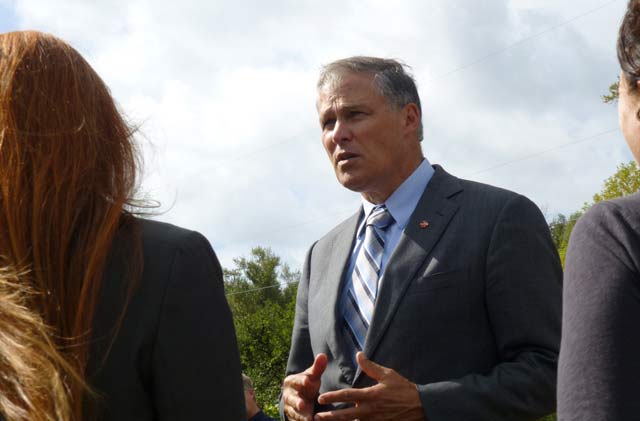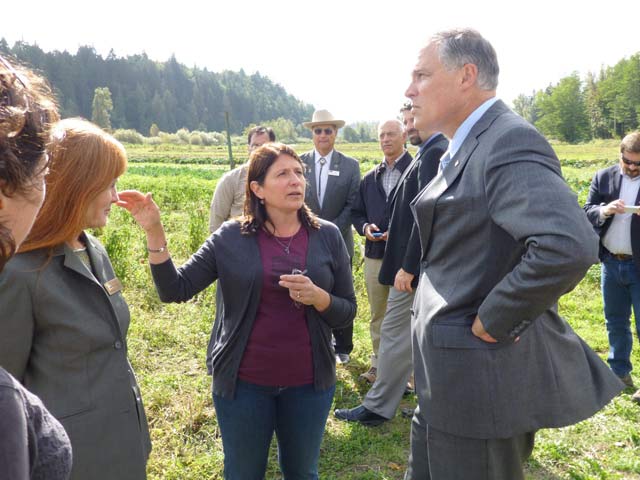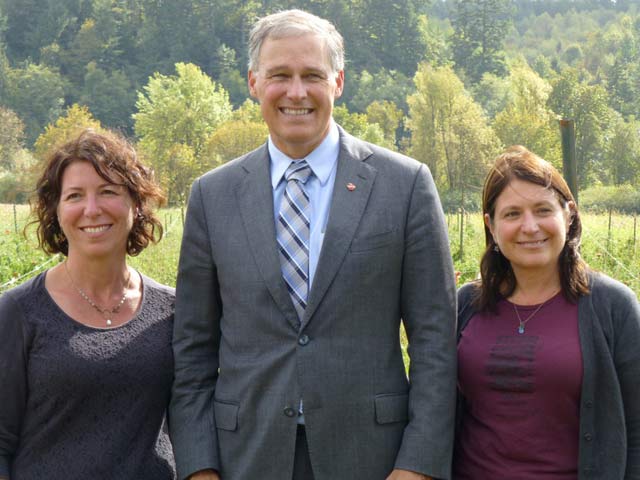
Part of the Series
Planet or Profit
The Chehalis River Valley is stunningly beautiful, verdant and home to some of the most bountiful farms in Washington State. From Christmas trees to flowers to some of the most luscious tomatoes you could ever eat, on a sunny day, it feels like one has landed in paradise here.
Unfortunately, the valley is also the site of some of the worst floods in the Pacific Northwest. The flooding has devastated farms, left bloated cattle corpses hanging from barn rafters and left some farmers themselves dead.
This is the location Gov. Jay Inslee chose to include as part of his climate tour in order to make a point.
Susan Ujcic, a Washington State farmer here who runs one of the largest community-supported agriculture businesses in the state, is intimately familiar with the impacts of anthropogenic climate disruption (ACD).
The Helsing Junction Farm where she works, located right on the banks of the Chehalis River, now has to be relocated every year due to flooding.
“We’ve had five record-setting, 100-year floods just since 1986,” Ujcic told Truthout while standing in a field at her farm in September. “So we’ve learned to mitigate. Every year since 2007, on November 1, we move all our equipment, inventory and office to higher ground, and in the spring, after flooding season, we move back.”
Ujcic is lucky enough to live in a state governed by Inslee, a man known as the “green governor”: He has designated ACD to be the single most important issue for he and his cabinet. And on the same day Truthout spoke with Ujcic, Inslee was visiting her farm, striving to help her and others in his state who are bearing the brunt of the impact from ACD.
“Here we are hopeful because when we see local impacts like flooding in the Chehalis, lack of irrigation in Yakima, ocean acidification hurting the oyster industry here, these are people having to deal with real world issues,” Inslee told Truthout. “It’s not an ideological debate. We want real world solutions.”
 Washington farmer Susan Ujcic shows Governor Inslee an area of her farm that now regularly floods due primarily to anthropogenic climate disruption. (Photo: Dahr Jamail / Truthout)
Washington farmer Susan Ujcic shows Governor Inslee an area of her farm that now regularly floods due primarily to anthropogenic climate disruption. (Photo: Dahr Jamail / Truthout)
And it is precisely these “real world solutions” that Inslee is working toward . . . but the clock is ticking.
“Disruptive Change”
Inslee understands how deep the crisis of anthropogenic climate disruption (ACD) runs.
“We know that two of the most challenging threats we face to our environment are climate change and ocean acidification,” Inslee said just after being elected governor of his home state in January 2013. He promised “disruptive change” to the way his state operated, and his actions have followed suit.
In September 2014, Inslee told a gathering of climate researchers at the University of Washington that Americans who remained neutral or indifferent on the subject of ACD were just as guilty as ACD deniers. During the conference, Inslee cited numerous studies that revealed the depths of ACD’s impacts on oceans, birds and human health, and went on to say that no one can remain on the sidelines any longer.
“This is the thing that continues to shock me: that not everyone is convinced of the need of action,” he said. “And I am not just talking about climate deniers who have a frontal denial, an explicit denial of climate science. Climate agnostics, climate inactivists, climate pacifists. People who are not engaged in this. That passivity is equally lethal to the prospects of our grandchildren.”
Inslee has consistently mentioned his grandchildren whenever he discusses ACD, and his actions as governor have reflected this line of thought. He has appointed a task force to develop a market-based carbon-reduction plan, such as a cap-and-trade system or carbon tax, which he aims to send to his state’s legislature in 2015.
In July, Inslee joined Gov. Jerry Brown of California and Gov. John Kitzhaber of Oregon in signing a letter opposing new oil and gas leases in the waters off the West Coast. (The letter can be read here.)
Inslee spent nearly a decade and a half in Washington, DC, as a congressman, but decided to come back to his home state to do the work he now sees as his legacy.
Truthout asked him why he made the change.
“I love Washington [State], to start with,” he said. “We’ve got an opportunity here, the door is open much wider, the possibilities are endless and this is a place where innovation takes place. So it’s a perfect place to innovate when it comes to policy and dealing with carbon pollution.”
He described the circumstances in the US House of Representatives as “extremely problematic because the climate change deniers are still in charge of that policy” and said he hopes that it is possible to enact “real world solutions” using a bipartisan approach to the problem of ACD.
Talking with the governor in Chehalis, Washington, an area that is now taking the brunt of ACD on the chin in the form of ongoing flooding, underscored his points.
“It’s easy to have an ideological debate in DC, but it’s harder to ignore a real problem here in Chehalis, and I hope that’s going to help us succeed,” he said. “Now the elections this November may have some bearing; I still have some challenges in my state senate to overcome, and one way or another, we want to find a consensus-driven approach there.”
Republicans in the state legislature have been opposing his efforts to work to mitigate the impacts of ACD. But he has pushed forward nonetheless.
On April 29, Inslee signed an executive order initiating a series of actions to reduce carbon emissions in Washington State and meet the state’s statutory carbon emission limits. One of the action items from his order is a directive stating that state agencies are to work with key utilities to reduce, and eventually eliminate, the use of electrical power produced by coal. Another of the actions is aimed toward greater energy efficiency, where the state’s Department of Commerce is directed to work with Washington State University (and other institutions) to significantly improve the energy performance of public and private buildings.
The White House released its National Climate Assessment, which highlighted numerous impacts already happening in Washington State that threaten essential water resources in places like the Yakima Valley, drive more devastating wildfires and threaten the state’s shellfish industry and salmon fisheries.
Even before the White House released its assessment, Inslee had initiated a “climate tour”: an ongoing series of meetings with people around the state where ACD has been causing damage.
According to his office, Inslee’s tour started with a visit to the Taylor Shellfish Dabob Bay hatchery and Taylor Shellfish processing facility, and held a shellfish industry roundtable to discuss the impacts ocean acidification is having on the industry. In July, the governor toured the city of Anacortes’ new water treatment plant to discuss adaptation efforts to address more severe flooding as a result of climate change.
More recently Inslee toured central and southwest Washington, visiting the Roza Irrigation District’s Re-Regulation Facility construction site in Wapato, a project that will enhance water resources in the Yakima basin, and met with local dairy farmers in Outlook to hear about their use of innovative digester technology to create energy and low-carbon transportation fuel from animal waste by-products. Later the governor announced a grant to Wind River Biomass Utility to support a clean energy heat and power generation plant using wood biomass fuel near Stevenson in Skamania County that will generate new jobs in the rural timber community.
Nevertheless, pressure on the governor to continue forward with his ACD-mitigating agenda continues.
Jay Gordon, the executive director of the Washington State Dairy Federation, is also a member of the governor’s climate change panel. Speaking with him at the Chehalis meeting was like speaking with an ACD scientist.
“Wherever the pollution is emitted, we are all going to feel it,” Gordon explained. “Chinese industrial particulates are causing a wetter/wet and drier/dry pattern here, and we are connecting their pollution to climate change and our increasingly extreme weather events here in Washington.”
Gordon, a sixth-generation farmer, added, “This is real, it is here, it is happening right now, and we and all the tribal farmers in this very area are all seeing and feeling these things.”
“The Science Is Clear”
Washington has one coal-fired power plant left – in Chehalis. That plant is scheduled to be shut down within eight years, Inslee told Truthout.
“We will have no coal-fired electricity in our state,” the governor said. “We are the first state to make sure that, in our programming decisions, we evaluate the carbon dioxide pollution, especially the burning of fossil fuels for export. We are the first ones to do that, and the reason that is important is because it doesn’t matter where the stuff is burned, that carbon dioxide, some of it ends up in our water. So my oyster growers are getting hurt, no matter where that carbon is being burned, because it ends up acidifying their waters.”
Gordon, who has seen his fellow farmers have to pull the carcasses of their cattle from the rafters of their barns after the severe flooding in the Chehalis area, is working with Inslee because he understands that there is no longer any time to wait when it comes to trying to mitigate impacts.
“What do we do about this, and how do we deal with it: These are the most important questions for all of us now,” he said.
Inslee told Truthout that his administration is currently moving forward on “multiple fronts,” and by November his ACD-task force will have a multi-pronged approach on how to meet his state’s carbon dioxide goals.
“We’re looking at a low-carbon fuel standard; we’re looking at a cap-and-trade system; we’re looking at more efficiency standards; we’re looking at ways to help consumers make investments in efficiency and the like,” he said. “Some of that can be done through executive action, some of it takes legislative work, and we intend to do it the Washington way, which is to lead, innovate and win. We’re also working with other states, and within this California [and] British Columbia coalition.”
It is this attitude of moving forward toward solutions – rather than focusing on the roadblocks thrown up by politicians who receive financial backing from the fossil fuel industry – that makes Inslee unique. He also believes that ACD will force the issue as the impacts become more frequent, more severe and more costly.
“I think we have an opportunity now for people of both parties who could put away their ideological blinders and see this as a solution,” he says of the politicians in his own state that have battled his ACD strategies. “So here we have a Republican legislator whose hometowns are flooded on a more frequent basis and will be more increasingly frequent because of climate change. I think they should realize that. The science is clear. The broad community understands that. So now they are looking for a solution rather than a debate.”
According to NASA and the National Oceanic and Atmospheric Administration, this August and September were the two hottest months on record, respectively. Both agencies report that 2014 is currently on track to become the hottest year ever recorded.
 Annie Salafsky (L) and Susan Ujcic (R) with Washington State Gov. Jay Inslee, while he visited their farm. (Photo: Dahr Jamail / Truthout)
Annie Salafsky (L) and Susan Ujcic (R) with Washington State Gov. Jay Inslee, while he visited their farm. (Photo: Dahr Jamail / Truthout)
As Inslee met with farmers, tribal members and later high school students and teachers on his climate tour, his emphasis on working toward a solution continued.
“The solution to this problem could be a cap-and-trade system that caps carbon dioxide and generates revenues for bulwarks against flooding, emergency runways for cows,” he said. “I think more and more legislators can understand that they want a solution that is local, but will also end up reducing carbon pollution. So there is a win-win here that can happen in Washington State if everyone will just put away their ideology for a little bit, and help us find some solutions.”
With the impacts of ACD intensifying, and global carbon emissions projected to double by 2100 according to a recent MIT report, Inslee has his work cut out for him.
Inslee’s work is one reason why Ujcic said she does not feel like a victim from the extreme weather events that are now a regular occurrence in her area.
“We’re choosing to stay here and farm, so we’re not victims,” she said. “Governor Inslee is helping us now, and I’m grateful for that. But I wonder what farmers in other parts of the country are doing to deal with these impacts, and how they are getting by in states who have governors who continue to stick their heads in the sand.”
Our most important fundraising appeal of the year
December is the most critical time of year for Truthout, because our nonprofit news is funded almost entirely by individual donations from readers like you. So before you navigate away, we ask that you take just a second to support Truthout with a tax-deductible donation.
This year is a little different. We are up against a far-reaching, wide-scale attack on press freedom coming from the Trump administration. 2025 was a year of frightening censorship, news industry corporate consolidation, and worsening financial conditions for progressive nonprofits across the board.
We can only resist Trump’s agenda by cultivating a strong base of support. The right-wing mediasphere is funded comfortably by billionaire owners and venture capitalist philanthropists. At Truthout, we have you.
We’ve set an ambitious target for our year-end campaign — a goal of $119,000 to keep up our fight against authoritarianism in 2026. Please take a meaningful action in this fight: make a one-time or monthly donation to Truthout before December 31. If you have the means, please dig deep.